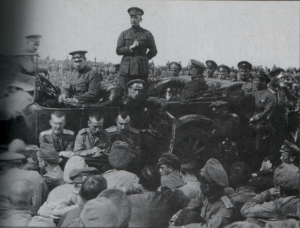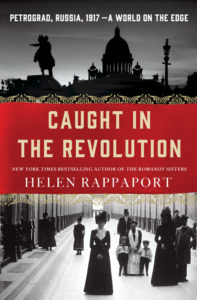by Helen Rappaport
It began many years ago – around twenty, if I recall correctly, when I visited a dusty and cluttered second-hand book shop in Burford in the Cotswolds. ‘Have you got any old books about Russia?’, I asked, this being the question I always asked during my compulsive book-collecting days. I had long been a collector of 18th and 19th century accounts of Russia, but on that particular day, ferreting through a particularly dirty pile of old books on the floor of an upstairs room in that book shop, I came across a tatty red book called I Photograph Russia.

It was a book written by an American photojournalist, James Abbe, who when he published this it in 1934, laid claim to being one of the first Western journalists to photograph Stalin’s Russia. I loved Abbe’s graphic, wisecracking account of how he took enormous risks to take the 80 photographs featured in his book in secret. The acquisition of Abbe’s book sparked a new line of collecting: eye witness accounts of Revolutionary and Soviet Russia. It soon became clear to me, as I searched, that there were many foreigners who found themselves in Petrograd for one reason or another – work, family, diplomatic or business assignment – who had had a firsthand view of events in the city during 1917.
I was of course aware, as anyone with an interest in the Revolution would be, that the most famous and enduring account of it by a foreigner was that by the Socialist journalist and writer, John Reed, doyen of the Greenwich Village set, whose book had been made even more famous by Warren Beatty’s film Reds in 1981. I also knew that Reed’s account was by no means the definitive one. For, in reality, despite his book being, on the surface, an account of the 1917 Revolution in Petrograd, it in fact only covers the October revolution. Reed and his wife, the equally celebrated Louise Bryant, did not even arrive in the city till September 1917 and missed all the turmoil and drama of not just the February Revolution, but also the violence of the July days and the high tension of the Kornilov revolt at the end of August. They never saw the huge protest marches, the food riots and the barricades on the Liteiny in the freezing cold of February. But during my years of seeking out and collecting eye witnesses of 1917, I had found numerous British, American and French residents who did – who wrote about it, and whose accounts had been lost or long forgotten.
Some of them were professional journalists – sent to cover the war on the eastern front and in haste sent on to Petrograd when the disturbances broke out. Many others were diplomats, particularly those of the wartime Allies Britain and France, and from April 1918, the USA. I found a whole range of people – men and women: businessmen representing companies such as Westinghouse and Singer, relief workers for the Red Cross and the Root Mission; military and naval attaches advising the Russian government; nannies and governesses (English and Scottish ones were particularly popular in pre revolutionary Russia); writers, spies, YMCA workers, young college grads working for the New York City Bank; actresses; nurses and doctors working at the Anglo-Russian hospital on the Nevsky Prospekt, and finally, the wives and mothers and children who had accompanied their men out to Petrograd and found themselves caught up in the thick of revolutionary events.
Virtually none of the many wonderful eyewitnesses I found – after years of searching in bookshops, and online library catalogs – had an overt political agenda. Which is why their accounts were, in the main, so revealing and refreshing. They were writing letters home to mother, or entries in private diaries describing what they saw as it happened, with no attention to political correctness or political interpretation. They wrote what they saw. In contrast to the heavily politicized account of the Bolshevik sympathizer and supporter John Reed, these unknown eyewitnesses were often far more objective; and also far more human.
If there is one overwhelming message all my many and varied eyewitnesses conveyed – from the most privileged diplomats in their embassies to journalists roughing it in bug and bullet ridden hotels, it was how hungry they all were. Few if any had time for, or took an interest in, the mind numbing political debate, the marches and pamphleteering of the numerous competing political parties, or the speech-making of their leaders Lenin, Trotsky, Kerensky et al. All they cared about was staying alive, keeping warm and getting enough to eat. This is not to mention the daily necessity of dodging the bullets, for during that extremely volatile year, outbreaks of violence, anarchy and looting were legion and you never knew, when walking down the street on an innocent shopping trip to find bread, what you might encounter, where the next demonstration or street fight might break out.

While John Reed might have enjoyed a largely posthumous celebrity (he died in Russian of spotted typhus in October 1920) very few of the men and women whose stories I tracked in Petrograd in 1917 ever made a mark on history. The vast majority of them, even if they wrote books about their experiences, remained unsung. One such was the intrepid Florence Harper, a reporter for Leslie’s Magazine who went out to Petrograd with photographer Donald Thompson to report on events, endured some very hairy, dangerous moments caught up in the rioting and shooting on the Nevsky, and met heroines like Maria Bochkareva commander of the Women’s Death Battalion. Harper’s vivid account Runaway Russia, was one of the first western accounts to published – in New York in 1918 – but after her return from Russia and a handful of articles in the American press she completely disappears from the record. I would have liked to say something about her life after the revolution but could find no trace. She is one of many key eyewitnesses in my book about whom I could find very little after 1917.
Caught in the Revolution is, for this reason, my way of saluting the wonderful accounts and the valuable testimony that these extraordinary and often courageous people have left of the human – rather than the political side of the story. They were all in various ways caught up in events that year and have left historians such as myself with a treasure trove of primary source material.
HELEN RAPPAPORT is the New York Times bestselling author of The Romanov Sisters. She studied Russian at Leeds University and is a specialist in Russian and Victorian history. She lives in West Dorset.

